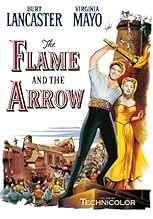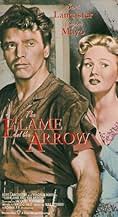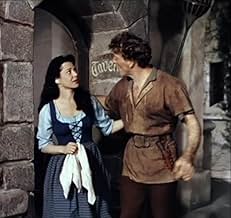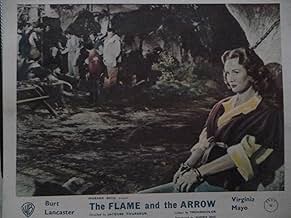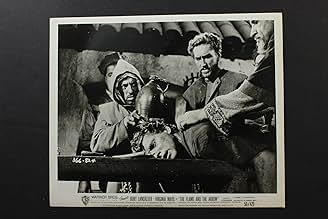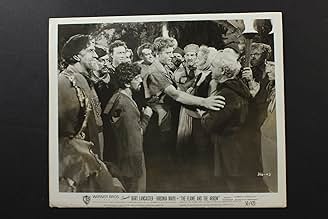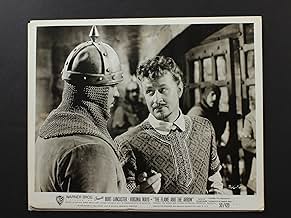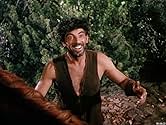IMDb RATING
6.8/10
4.5K
YOUR RATING
Dardo, a Robin Hood-like figure, and his loyal followers use a Roman ruin in Medieval Lombardy as their headquarters as they conduct an insurgency against their Hessian conquerors.Dardo, a Robin Hood-like figure, and his loyal followers use a Roman ruin in Medieval Lombardy as their headquarters as they conduct an insurgency against their Hessian conquerors.Dardo, a Robin Hood-like figure, and his loyal followers use a Roman ruin in Medieval Lombardy as their headquarters as they conduct an insurgency against their Hessian conquerors.
- Nominated for 2 Oscars
- 2 wins & 2 nominations total
Lynn Baggett
- Francesca
- (as Lynne Baggett)
Paul Baxley
- Guard
- (uncredited)
Leon Belasco
- Arturo of Milan
- (uncredited)
- …
Ray Beltram
- Townsman
- (uncredited)
Richard Brehm
- Outlaw
- (uncredited)
George Bruggeman
- Guard
- (uncredited)
- Director
- Writer
- All cast & crew
- Production, box office & more at IMDbPro
Featured reviews
Lively, colorful period romp in the Warners’ style made in the wake of ADVENTURES OF DON JUAN (1948) – featuring the same villain, Robert Douglas, no less – but actually fashioned after their most successful swashbuckler, THE ADVENTURES OF ROBIN HOOD (1938).
Burt Lancaster – with his acrobatic training and cheerful countenance in full bloom – is perfect casting for the heroic role of Dardo, a kind of Italian Robin Hood (even down to displaying similar prowess as an archer); Virginia Mayo, then, makes for an ideal heroine – like Olivia De Havilland’s Maid Marian, playing a noble woman who’s gradually drawn to the outlaw’s cause. Again, like the 1938 Robin Hood film, we have two villains: Frank Allenby as a tyrant known as “The Hawk” and the afore-mentioned Douglas as a Marquis; the latter’s role is interesting in that, banished by the former for tax evasion, he manages to infiltrate Lancaster’s band (along with his smart companion, a troubadour played by Norman Lloyd) and outwardly reform – but, when the opportunity arises, proceeds to reveal their plan of attack to Allenby!
Other twists and quirks to the Robin Hood formula (the sharp script was written by Waldo Salt, later an Oscar winner for MIDNIGHT COWBOY [1969]!) are the fact that Lancaster’s wife has left him for Allenby - their spirited son has remained with Lancaster, whom he idolizes, but is eventually captured and thought good manners against his will; when Lancaster imprisons Mayo in exchange for his son’s freedom, he keeps her chained by the neck to a tree!; for no apparent reason other than that he's able to, one of Lancaster’s men uses his feet to write ransom notes, etc.; Lancaster is sent to the gallows but, here, he gives himself up rather than being captured and actually fakes his own death!; and the climactic struggle inside the castle, which the gang penetrate incognito (this time dressed-up as a band of strolling players). The obligatory swordfight between Lancaster and Douglas, then, is given a novel touch by being partly set in the dark – the only evident nod to the noir style director Tourneur is best-known for!
The film itself received a couple of Oscar nominations for Ernest Haller’s gorgeous cinematography and Max Steiner’s marvelous score (it too bears a striking resemblance to Erich Wolfgang Korngold’s unforgettable work on THE ADVENTURES OF ROBIN HOOD – as do the castle interiors – but this takes nothing away from the quality of THE FLAME AND THE ARROW itself!). Also worth noting in the cast is Nick Cravat as Lancaster’s mute sidekick: in the star’s days as an acrobat, he had been his partner and would often work with him in films – basically reprising his role here in Lancaster’s next swashbuckler, the seafaring THE CRIMSON PIRATE (1952; incidentally, also surprisingly but vigorously helmed by an expert in film noir, Robert Siodmak). Speaking of the latter, a couple of years back I re-acquainted myself with it via a rental of Warner’s bare-bones DVD edition – but its predecessor/companion piece is, mysteriously, still M.I.A. on disc...
Burt Lancaster – with his acrobatic training and cheerful countenance in full bloom – is perfect casting for the heroic role of Dardo, a kind of Italian Robin Hood (even down to displaying similar prowess as an archer); Virginia Mayo, then, makes for an ideal heroine – like Olivia De Havilland’s Maid Marian, playing a noble woman who’s gradually drawn to the outlaw’s cause. Again, like the 1938 Robin Hood film, we have two villains: Frank Allenby as a tyrant known as “The Hawk” and the afore-mentioned Douglas as a Marquis; the latter’s role is interesting in that, banished by the former for tax evasion, he manages to infiltrate Lancaster’s band (along with his smart companion, a troubadour played by Norman Lloyd) and outwardly reform – but, when the opportunity arises, proceeds to reveal their plan of attack to Allenby!
Other twists and quirks to the Robin Hood formula (the sharp script was written by Waldo Salt, later an Oscar winner for MIDNIGHT COWBOY [1969]!) are the fact that Lancaster’s wife has left him for Allenby - their spirited son has remained with Lancaster, whom he idolizes, but is eventually captured and thought good manners against his will; when Lancaster imprisons Mayo in exchange for his son’s freedom, he keeps her chained by the neck to a tree!; for no apparent reason other than that he's able to, one of Lancaster’s men uses his feet to write ransom notes, etc.; Lancaster is sent to the gallows but, here, he gives himself up rather than being captured and actually fakes his own death!; and the climactic struggle inside the castle, which the gang penetrate incognito (this time dressed-up as a band of strolling players). The obligatory swordfight between Lancaster and Douglas, then, is given a novel touch by being partly set in the dark – the only evident nod to the noir style director Tourneur is best-known for!
The film itself received a couple of Oscar nominations for Ernest Haller’s gorgeous cinematography and Max Steiner’s marvelous score (it too bears a striking resemblance to Erich Wolfgang Korngold’s unforgettable work on THE ADVENTURES OF ROBIN HOOD – as do the castle interiors – but this takes nothing away from the quality of THE FLAME AND THE ARROW itself!). Also worth noting in the cast is Nick Cravat as Lancaster’s mute sidekick: in the star’s days as an acrobat, he had been his partner and would often work with him in films – basically reprising his role here in Lancaster’s next swashbuckler, the seafaring THE CRIMSON PIRATE (1952; incidentally, also surprisingly but vigorously helmed by an expert in film noir, Robert Siodmak). Speaking of the latter, a couple of years back I re-acquainted myself with it via a rental of Warner’s bare-bones DVD edition – but its predecessor/companion piece is, mysteriously, still M.I.A. on disc...
"The Flame & The Arrow" (1950)was one of the last of the great Warner Bros. swashbucklers. From a screenplay by Waldo Salt this hugely enjoyable romp was directed with great flair by Jacques Tourneur. It was originally planned as a vehicle for Errol Flynn but by the time the picture went into production the erstwhile heroic Flynn was past his sell-by date and would be unable for the knockabout antics the part demanded (he had barely got through "The Adventures Of Don Juan" two years previously thanks to many short takes and having doubles perform a lot of his action scenes). Instead, a young and stunningly acrobatic Burt Lancaster was cast as Dardo, a sort of Robin Hood in medieval Italy fighting the oppression of the occupying Hessions.
Produced by Lancaster's Norma Productions (named after his wife) it was fully fleshed out with a splendid cast. Playing Dardo's mute friend Piccolo was Nick Cravat - Lancaster's friend and fellow performer from their circus days.The lovely Virginia Mayo played the love interest Anne of Hess. Robert Douglas is a likable rogue through most of the picture until he gets a taste of power and turns bad and Frank Allenby, looking remarkably like the Great Profile John Barrymore, played the villainous Hawk (the original title of the movie was "The Hawk & The Arrow").
Lancaster is marvellous to watch! Performing all his own stunts his high flying antics are a joy to behold. No other actor, before or since, would prove to be so agile and provide such a spirited performance! His athletic prowess is outstanding and little wonder he was Warner's first choice to play the great native American athlete Jim Thorpe in their biographical "Jim Thorpe-All American" (aka "Man Of Bronz") in 1952. Although he did a kind of follow-up to "The Flame & The Arrow" two years later with the more comical "The Crimson Pirate" it is a shame he then ceased doing this type of movie as we could have tolerated him in quite a few more of them.
Beautifully photographed in colour by the great Ernest Haller the movie has all the hallmarks of Warner's high production values. Adding greatly to the picture's proceedings is the wonderful Italianate score by Max Steiner! His ebullient music, like the picture, is a total delight especially his infectious and hum inducing main theme for Dardo scored for mandolins and orchestra and the gorgeous love theme for the scenes with Dardo & the lady Anne. There's a splendid driving battle theme too! Steiner's music was nominated for an Acadamy Award but lost out to Franz Waxman's darker "Sunset Boulevard".
The picture has transferred extremely well to disc with sharp images and fine colour resolution but quite dispensable are a Merrie Melodies cartoon and a tired Joe McDoakes short. It is also a pity that a documentary of Lancaster was not included.
Produced by Lancaster's Norma Productions (named after his wife) it was fully fleshed out with a splendid cast. Playing Dardo's mute friend Piccolo was Nick Cravat - Lancaster's friend and fellow performer from their circus days.The lovely Virginia Mayo played the love interest Anne of Hess. Robert Douglas is a likable rogue through most of the picture until he gets a taste of power and turns bad and Frank Allenby, looking remarkably like the Great Profile John Barrymore, played the villainous Hawk (the original title of the movie was "The Hawk & The Arrow").
Lancaster is marvellous to watch! Performing all his own stunts his high flying antics are a joy to behold. No other actor, before or since, would prove to be so agile and provide such a spirited performance! His athletic prowess is outstanding and little wonder he was Warner's first choice to play the great native American athlete Jim Thorpe in their biographical "Jim Thorpe-All American" (aka "Man Of Bronz") in 1952. Although he did a kind of follow-up to "The Flame & The Arrow" two years later with the more comical "The Crimson Pirate" it is a shame he then ceased doing this type of movie as we could have tolerated him in quite a few more of them.
Beautifully photographed in colour by the great Ernest Haller the movie has all the hallmarks of Warner's high production values. Adding greatly to the picture's proceedings is the wonderful Italianate score by Max Steiner! His ebullient music, like the picture, is a total delight especially his infectious and hum inducing main theme for Dardo scored for mandolins and orchestra and the gorgeous love theme for the scenes with Dardo & the lady Anne. There's a splendid driving battle theme too! Steiner's music was nominated for an Acadamy Award but lost out to Franz Waxman's darker "Sunset Boulevard".
The picture has transferred extremely well to disc with sharp images and fine colour resolution but quite dispensable are a Merrie Melodies cartoon and a tired Joe McDoakes short. It is also a pity that a documentary of Lancaster was not included.
THE FLAME AND THE ARROW is one (1) of those films that every ten (10) years we see and are pleasantly surprised how well it holds up. It is also amazing how it appears and disappears. In the 60's it was on quite frequently, the 70's not so. American Movie Classics (AMC) showed it often in the 80's and it came out on VHS. Now it is been buried again so a new generation of viewers are going to have to wait till it comes out on DVD. I have just watched my 80's VHS recently so this is based upon it.
It is what other commentators called it ROBIN HOOD JR. That does not mean it is small or poorly made film. Instead you see the full power of a major studio Warner Brothers (WB) behind it. The props and sets many coming from larger films (Adventures of Robin Hood, Elizabeth and Essex, The Adventures of Don Juan) are quite evident and effectively integrated into the story line. Burt Lancaster's supporting cast consists of the current studio stock company, all professionals. Who knew what to deliver and did so. It had the full Three (3) Strip Technicolor process in all it's glory and finally Max Steiner's score. Romantic and rich and appropriate for such a concept. This is a super 'B' film and there is no disgrace in that. We have seen plenty of 'A' films today that are not half as well done.
It is though Burt Lancaster that is the central focus of the film. His first 'independent' production he knew if he did not carry it well it would have failed. Every time he is on the screen he is the focus of attention and fortunately he is on very often. Whether exchanging insults, engaging in acrobatics or romance he is hitting the target every time. He is ably supported by Virginia Mayo as his leading lady. A underrated actress with a attractive and strong physical presence. Lets be frank, does anyone believe that DARDO would fall for some skinny twit like Audrey Hepburn (or today Angelina Jolie) no way. We did not believe that when Sean Connery did in ROBIN AND MARIAN!
So if you can check this selection out. Your library may have a copy (mine does) on VHS. We are sure it will be out sometime on DVD. Lancaster later made another period film THE CRIMSON PIRATE. Not quite as good but still fun, but it seemed to lack the backing. polish and push that WB gave THE FLAME AND THE ARROW.
ADDENDUM; NOW AVAILABLE ON DVD.
It is what other commentators called it ROBIN HOOD JR. That does not mean it is small or poorly made film. Instead you see the full power of a major studio Warner Brothers (WB) behind it. The props and sets many coming from larger films (Adventures of Robin Hood, Elizabeth and Essex, The Adventures of Don Juan) are quite evident and effectively integrated into the story line. Burt Lancaster's supporting cast consists of the current studio stock company, all professionals. Who knew what to deliver and did so. It had the full Three (3) Strip Technicolor process in all it's glory and finally Max Steiner's score. Romantic and rich and appropriate for such a concept. This is a super 'B' film and there is no disgrace in that. We have seen plenty of 'A' films today that are not half as well done.
It is though Burt Lancaster that is the central focus of the film. His first 'independent' production he knew if he did not carry it well it would have failed. Every time he is on the screen he is the focus of attention and fortunately he is on very often. Whether exchanging insults, engaging in acrobatics or romance he is hitting the target every time. He is ably supported by Virginia Mayo as his leading lady. A underrated actress with a attractive and strong physical presence. Lets be frank, does anyone believe that DARDO would fall for some skinny twit like Audrey Hepburn (or today Angelina Jolie) no way. We did not believe that when Sean Connery did in ROBIN AND MARIAN!
So if you can check this selection out. Your library may have a copy (mine does) on VHS. We are sure it will be out sometime on DVD. Lancaster later made another period film THE CRIMSON PIRATE. Not quite as good but still fun, but it seemed to lack the backing. polish and push that WB gave THE FLAME AND THE ARROW.
ADDENDUM; NOW AVAILABLE ON DVD.
Both this film and The Crimson Pirate established Burt Lancaster's reputation in the swashbuckling genre. When discussing Lancaster's career even with Oscar nominations and one Oscar for roles vastly different than who he plays in The Flame And The Arrow, I find it fascinating that so many still refer back to these films and label Lancaster a swashbuckling star like Errol Flynn.
Taking place in medieval Lombardy, the province is part of the Holy Roman Empire and they have a particularly evil Hessian provincial governor in Frank Allenby, known as "the Hawk" for his partiality to falconry and for his rapacious designs. Five years before, Allenby just took for himself the bored wife of Burt Lancaster played by Lynne Baggett leaving him to raise their son Gordon Gebert.
Now however Allenby at Baggett's suggestion comes in and takes Gebert away from a wounded Lancaster. Up to this time Lancaster has lived isolated in the mountains. Now he finally decides to join the rebels in revolt against Allenby and the Empire. Nothing like a little child stealing to provide motivation.
Before taking up acting Lancaster and his partner Nick Cravat were circus performers and his natural abilities in that direction made producers want to cast him in films like The Flame And The Arrow. But Lancaster knew his talent and always tried and succeeded in getting better parts. He never did want to have the career of Errol Flynn.
Burt also gets the opportunity to romance Allenby's niece Virginia Mayo who is being offered to a recently impoverished count Robert Douglas in the hopes of peace and unity. Douglas however is working an agenda all his own in The Flame And The Arrow. Mayo is curiously enough the mirror image of Baggett. She's bored with court life and finds certain attractions among the peasants especially the lusty and charismatic Lancaster.
And Burt has the charisma going full blast in this film. As well he would have to, otherwise why would the peasants be following him. It's an expansive part and no one could be as expansive as Burt Lancaster when the part called for it.
The Flame And The Arrow holds up well today. It should as it has a universal theme of a man protecting his child.
Taking place in medieval Lombardy, the province is part of the Holy Roman Empire and they have a particularly evil Hessian provincial governor in Frank Allenby, known as "the Hawk" for his partiality to falconry and for his rapacious designs. Five years before, Allenby just took for himself the bored wife of Burt Lancaster played by Lynne Baggett leaving him to raise their son Gordon Gebert.
Now however Allenby at Baggett's suggestion comes in and takes Gebert away from a wounded Lancaster. Up to this time Lancaster has lived isolated in the mountains. Now he finally decides to join the rebels in revolt against Allenby and the Empire. Nothing like a little child stealing to provide motivation.
Before taking up acting Lancaster and his partner Nick Cravat were circus performers and his natural abilities in that direction made producers want to cast him in films like The Flame And The Arrow. But Lancaster knew his talent and always tried and succeeded in getting better parts. He never did want to have the career of Errol Flynn.
Burt also gets the opportunity to romance Allenby's niece Virginia Mayo who is being offered to a recently impoverished count Robert Douglas in the hopes of peace and unity. Douglas however is working an agenda all his own in The Flame And The Arrow. Mayo is curiously enough the mirror image of Baggett. She's bored with court life and finds certain attractions among the peasants especially the lusty and charismatic Lancaster.
And Burt has the charisma going full blast in this film. As well he would have to, otherwise why would the peasants be following him. It's an expansive part and no one could be as expansive as Burt Lancaster when the part called for it.
The Flame And The Arrow holds up well today. It should as it has a universal theme of a man protecting his child.
I honestly feel if anyone is does this film down for it's jovial nature then they surely are missing the point. I wasn't around at the time of its release, but I would have been surprised if the makers had marketed it as a searing swashbuckler for the ages. The film is fun, it tells a fun tale, and yes it's in the Robin Hood arc of plot structure, but ultimately it's a tale well worth watching due to the extended dexterity of its stars.
I would think that tagging this film "The Acrobatic Peasant Vs The Horrible Hessian Lord" would serve it about right, the cast are having fun and really the viewer should be in on the joviality unfolding as well. Burt Lancaster and his old circus performing pal Nick Cravat dazzle with flings and flops, arrows and lances, and it all works for what I term perfect Sunday afternoon entertainment.
All that and Viginia Mayo has a smile that could stop an army in its tracks, what more do you want ?, hooray ! 7/10
I would think that tagging this film "The Acrobatic Peasant Vs The Horrible Hessian Lord" would serve it about right, the cast are having fun and really the viewer should be in on the joviality unfolding as well. Burt Lancaster and his old circus performing pal Nick Cravat dazzle with flings and flops, arrows and lances, and it all works for what I term perfect Sunday afternoon entertainment.
All that and Viginia Mayo has a smile that could stop an army in its tracks, what more do you want ?, hooray ! 7/10
Did you know
- TriviaNick Cravat, who plays Piccolo, was an acrobat who was teamed with Burt Lancaster before Lancaster became a star. He appears in many of Lancaster's movies. In this one, and in Le corsaire rouge (1952), he plays a mute. The reason was that his thick Brooklyn accent, which he could not lose, would have been wildly out of place in such period pieces.
- GoofsWhen Piccolo is fighting the guardsman in the balcony he flips his sword around and holds the blade with his hand (showing it cannot be sharp) and then whacks the guardsman with the broad side of the blade near the hilt, bending it at least 20-25 degrees.
- ConnectionsReferenced in The John Player Lecture with Burt Lancaster (1972)
- How long is The Flame and the Arrow?Powered by Alexa
Details
- Release date
- Country of origin
- Language
- Also known as
- El halcón y la flecha
- Filming locations
- Production companies
- See more company credits at IMDbPro
Box office
- Budget
- $1,600,000 (estimated)
- Gross worldwide
- $6,713
- Runtime
- 1h 28m(88 min)
- Aspect ratio
- 1.37 : 1
Contribute to this page
Suggest an edit or add missing content


